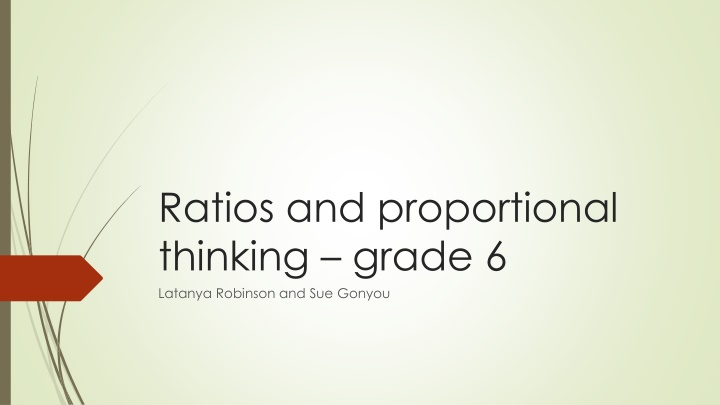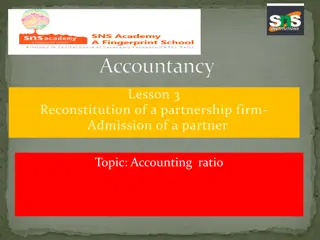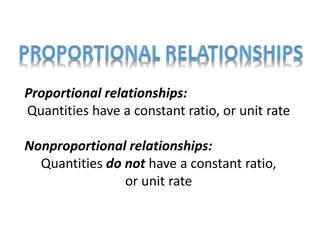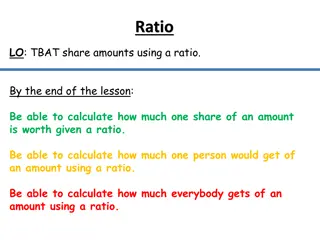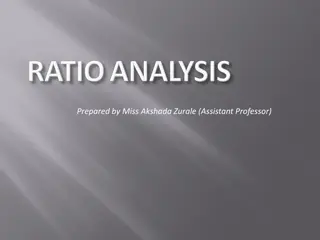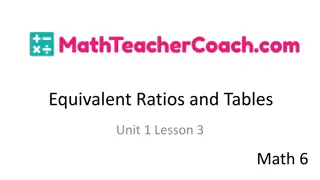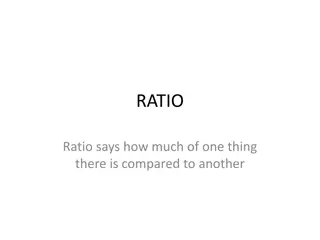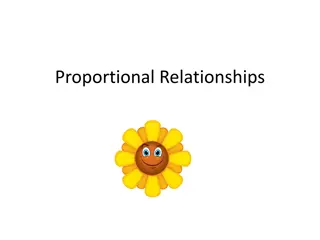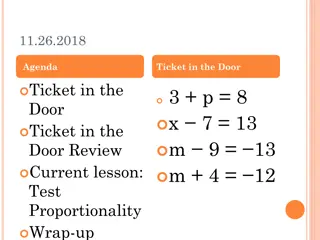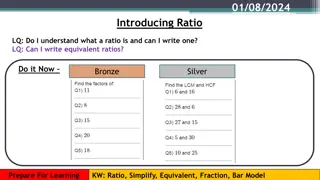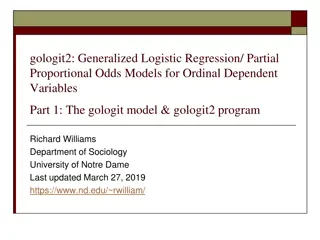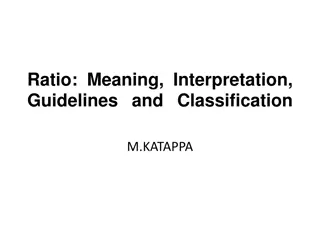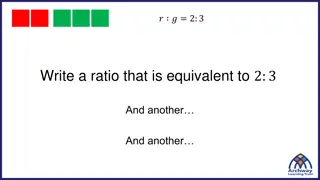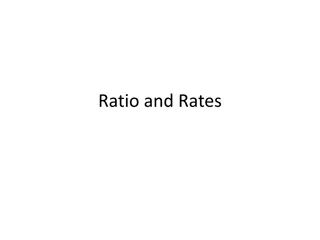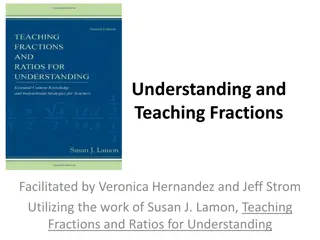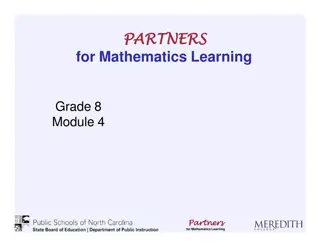Ratios and proportional thinking-grade 6
Interpret and compute fractions quotients, solving word problems using visual models and equations. Explore the meaning of division and multiplication through repeated addition and finding missing factors. Discover the division of fractions by fractions and the relationships of multiplication and division.
Download Presentation

Please find below an Image/Link to download the presentation.
The content on the website is provided AS IS for your information and personal use only. It may not be sold, licensed, or shared on other websites without obtaining consent from the author.If you encounter any issues during the download, it is possible that the publisher has removed the file from their server.
You are allowed to download the files provided on this website for personal or commercial use, subject to the condition that they are used lawfully. All files are the property of their respective owners.
The content on the website is provided AS IS for your information and personal use only. It may not be sold, licensed, or shared on other websites without obtaining consent from the author.
E N D
Presentation Transcript
Ratios and proportional thinking grade 6 Latanya Robinson and Sue Gonyou
Standard (6. Number System.1) Interpret and compute quotients of fractions and solve word problems involving division of fractions by fractions using visual models, equations, and creating a story context BIG IDEA: Students use the meaning of fractions and reasoning about multiplication and division to explain why the procedure for dividing fractions make sense.
Students need to know the meaning of division and multiplication. Multiplication: Repeated addition
Division: Finding the missing factor, or repeated subtraction
Division: Finding the missing factor, or repeated subtraction
Division of Fractions by Fractions: computing, modeling, interpreting Fraction Whole Number
Division of Fractions by Fractions: computing, modeling, interpreting Fraction Whole Number
Connecting Invert and Multiply to Relationships of Multiplication and Division
Connecting Invert and Multiply to Relationships of Multiplication and Division
Credits Jordan School District, June 2011 http://elemmath.jordandistrict.org/teachers/6thgrad e/conceptual-foundations/ Engage NewNY https://www.engageny.org/resource/grade-6- mathematics-module-2-topic-overview http://knpb.pbslearningmedia.org/resource/mgbh.math.nf.fracmultmodel/area-model- for-multiplication-of-fractions/ fraction times a fraction http://knpb.pbslearningmedia.org/resource/mket- math-ns-kidvid2/kidvid2/ Apllication problem
Chichn Itz was a Mayan city in what is now Mexico. The picture below shows El Castillo, also known as the pyramid of Kukulc n, which is a pyramid located in the ruins of Chich n Itz . The temple at the top of the pyramid is approximately 24 meters above the ground, and there are 91 steps leading up to the temple. How high above the ground would you be if you were standing on the 50th step?
CCSS.Math.Content.6.RP.A.1 Understand the concept of a ratio and use ratio language to describe a ratio relationship between two quantities. For example, "The ratio of wings to beaks in the bird house at the zoo was 2:1, because for every 2 wings there was 1 beak." "For every vote candidate A received, candidate C received nearly three votes. CCSS.Math.Content.6.RP.A.3.a Make tables of equivalent ratios relating quantities with whole-number measurements, find missing values in the tables, and plot the pairs of values on the coordinate plane. Use tables to compare ratios. Bag of Marbles Alignments to Content Standards: 6.RP.A.3.a 6.RP.A.1 In a bag of marbles, 3/5 of the marbles are blue and the rest are red. If the number of red marbles is doubled and the number of blue marbles stays the same, what fraction of the marbles will be red? Blue Red 3 5 (2) 3 10
CCSS.Math.Content.6.RP.A.2 Understand the concept of a unit rate a/b associated with a ratio a:b with b 0, and use rate language in the context of a ratio relationship. For example, "This recipe has a ratio of 3 cups of flour to 4 cups of sugar, so there is 3/4 cup of flour for each cup of sugar." "We paid $75 for 15 hamburgers, which is a rate of $5 per hamburger."1 CCSS.Math.Content.6.RP.A.3 Use ratio and rate reasoning to solve real-world and mathematical problems, e.g., by reasoning about tables of equivalent ratios, tape diagrams, double number line diagrams, or equations. Riding at a Constant Speed, Assessment Variation Alignments to Content Standards: 6.RP.A.2 6.RP.A.3 Lin rode a bike 20 miles in 150 minutes. If she rode at a constant speed, How far did she ride in 15 minutes? How long did it take her to ride 6 miles? How fast did she ride in miles per hour? What was her pace in minutes per mile? 20 150 ? 15
CCSS.Math.Content.6.RP.A.3.b Solve unit rate problems including those involving unit pricing and constant speed. For example, if it took 7 hours to mow 4 lawns, then at that rate, how many lawns could be mowed in 35 hours? At what rate were lawns being mowed? Friends Meeting on Bicycles Alignments to Content Standards: 6.RP.A.3 6.RP.A.3.b Task Taylor and Anya live 63 miles apart. Sometimes on a Saturday, they ride their bikes toward each other's houses and meet somewhere in between. Taylor is a very consistent rider - she finds that her speed is always very close to 12.5 miles per hour. Anya rides more slowly than Taylor, but she is working out and so she is becoming a faster rider as the weeks go by. On a Saturday in July, the two friends set out on their bikes at 8 am. Taylor rides at 12.5 miles per hour, and Anya rides at 5.5 miles per hour. After one hour, how far apart are they? Make a table showing how far apart the two friends are after zero hours, one hour, two hours, and three hours. At what time will the two friends meet? Taylor says, "If I ride at 12.5 miles per hour toward you, and you ride at 5.5 miles per hour toward me, it's the same as if you stay still and I ride at 18 miles per hour." What do you think Taylor means by this? Is she correct? A couple of months later, on a Saturday in September, the two friends set out again on their bikes at 8 am. Taylor, as always, rides at 12.5 miles per hour. This time they meet at 11 am. How fast was Anya riding this time?
CCSS.Math.Content.6.RP.A.3.d Use ratio reasoning to convert measurement units; manipulate and transform units appropriately when multiplying or dividing quantities. Speed Conversions Alignments to Content Standards: 6.RP.A.3.d Jessica sees the following speed limit sign while visiting Australia where the units for speed are kilometers per hour: km Miles A conversion table indicates that 1 mile is 1.6 km. With this conversion rate, is the speed limit greater than or less than 65 mph? Explain. Jessica finds out that 1 mile is not exactly 1.6 km. This number has been rounded to the nearest tenth. Does this influence the answer to part (a)?
I have found using tape diagrams is most effective when a total is involved, such as the problem below: Amy has 2 cats and 3 dogs. Jeff s pets are in the same ratio but he has a total of 10 cats and dogs. How many of each does he have? Cats Dogs total 2 3 10
CCSS.Math.Content.6.RP.A.1 Understand the concept of a ratio and use ratio language to describe a ratio relationship between two quantities ratio language to describe a ratio relationship between two quantities. For example, "The ratio of wings to beaks in the bird house at the zoo was 2:1, because for every 2 wings there was 1 beak." "For every vote candidate A received, candidate C received nearly three votes." CCSS.Math.Content.6.RP.A.2 Understand the concept of a unit rate relationship. For example, "This recipe has a ratio of 3 cups of flour to 4 cups of sugar, so there is 3/4 cup of flour for each cup of sugar." "We paid $75 for 15 hamburgers, which is a rate of $5 per hamburger."1 unit rate a/b associated with a ratio a:b with b 0, and use rate language in the context of a ratio CCSS.Math.Content.6.RP.A.3 Use ratio and rate reasoning to solve real-world and mathematical problems, e.g., by reasoning about tables of equivalent ratios, tape diagrams, double number line diagrams, or equations. tape diagrams, double number line diagrams, or equations. equivalent ratios, CCSS.Math.Content.6.RP.A.3.a Make tables of equivalent ratios relating quantities with whole-number measurements, find missing values in the tables, and plot the pairs of values on the coordinate plane. Use tables to compare ratios. Use tables to compare ratios. CCSS.Math.Content.6.RP.A.3.b Solve unit rate problems Solve unit rate problems including those involving unit pricing and constant speed. For example, if it took 7 hours to mow 4 lawns, then at that rate, how many lawns could be mowed in 35 hours? At what rate were lawns being mowed? CCSS.Math.Content.6.RP.A.3.c Find a percent of a quantity as a rate Find a percent of a quantity as a rate per 100 (e.g., 30% of a quantity means 30/100 times the quantity); solve problems involving finding the whole, given a part and the percent. CCSS.Math.Content.6.RP.A.3.d Use ratio reasoning to convert measurement units Use ratio reasoning to convert measurement units; manipulate and transform units appropriately when multiplying or dividing quantities.
The big idea: Students need to identify proportional reasoning or percentages, recognizing rates and inferring other relationships, using equivalent ratios, ratio tables, double number lines and tape diagrams. These skills then can be applied to percentages.
